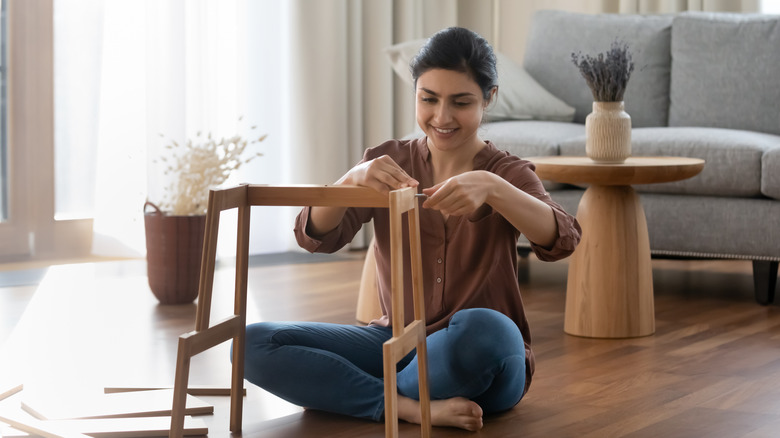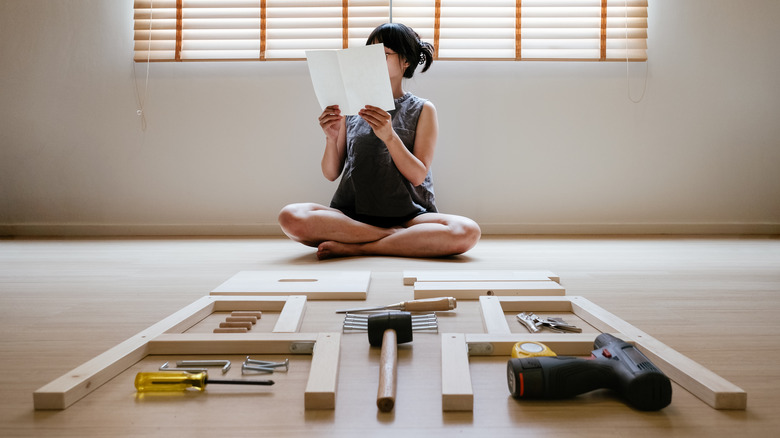The Reason IKEA Makes You Assemble Your Furniture
IKEA is a haven for affordable, simple, and functional furniture, but once you leave the store and head home with your collection of boxes, the entirety of the process may seem a bit less convenient. Furniture assembly — especially following a series of confusing photos instead of written instructions — is an annoyance at best, and a rage-inducing, several-day process at worst. Because of this, you might find yourself wondering why any brand that's committed to customer satisfaction would ever choose the DIY approach. The simple answer, as usual, comes down to money.
On IKEA's website, the response to this common query is simple: "Our products are designed to be assembled by you. That way, you'll save the most money." While this response does have quite a bit of truth to it, there are also a few other secondary motives to this model that go back to IKEA's very foundations as a mail-order company in 1940s Sweden.
Reason 1: Profit
At some point, someone has to assemble furniture in order for it to be usable. When buying from a high-end brand, that's typically someone working in a factory or at the store where you purchase the piece. Assembling furniture takes both time and effort, something you'll likely have learned on your own after shopping at somewhere like IKEA, and most companies naturally have to pay workers to perform this task.
At IKEA, however, the final step in the production process is left to the consumer. This means the company doesn't have to hire as many workers, build as many factories, or take as much time to get products in the hands of customers, so it doesn't have to shoulder nearly as many expenses as a brand with in-house assembly. People are still buying the furniture despite the assembly headache, so the combination of high revenue and relatively low expenses equals more profit in the hands of the company and the ability to keep prices low. With a gross profit of over $15 billion in 2022, it seems they have found a winning formula with the build-it-yourself approach.
Reason 2: Transportation and storage
IKEA is a global company that boasts 460 stores across 62 countries and optional international shipping when a local store isn't available. Its origins as a mail-order company make it perfectly equipped for this purpose, but this means that maximizing storage space and ease of transportation are top priorities.
Already-assembled tables and bookshelves take up much more space than all of the components carefully packed in boxes, and the fact that they're already in easy-to-transport packaging makes shipping much quicker and easier. If all of IKEA's furniture were already assembled, there would be issues with the storage and transportation process from the offset. Warehouses would be full of furniture that is difficult to stack and prone to damage, so preparing for shipment would become much more time- and labor-intensive. Additionally, in-store customers could face issues transporting their items in compact vehicles. When the priority is selling as many items to as many customers as possible, having them broken down into their parts to facilitate this process is common sense, both for the company and the consumer.
Reason 3: Psychology
This might be shocking if you've ever found yourself on the verge of flinging your tiny Allen wrench across the room, but assembling your own furniture can create a more positive view of the finished product. In a study from Harvard Business School, the authors coined a term known as "the IKEA effect," which describes the positive feeling that a consumer derives from being involved in the process of creating the item they purchased. This business model is seen everywhere, from Build-A-Bear Workshop to at-home cake mixes, and often creates a stronger connection than simply pulling something out of a box.
This study, however, did find that there were limits. If a project is too simple, the effect is diminished. However, you'll likely become frustrated if it's too challenging to finish. IKEA tends to toe the line between these two extremes, giving you a kit and instructions requiring moderate effort and a minor headache to complete. Once you have completed the assembly process, however, you likely feel satisfied that you built something, and you're more likely to have a favorable view of the product because of the effort that went into completing it.
IKEA's business model is rooted in increasing profit, but it surprisingly has connections to customer satisfaction as well. Assembling your furniture might not represent your perfect afternoon, but you can rest assured that the thought process behind this approach goes much deeper than slashing expenses.



